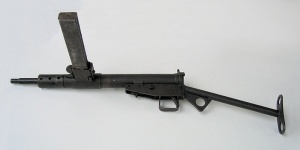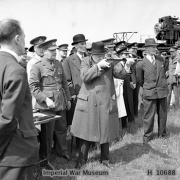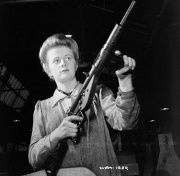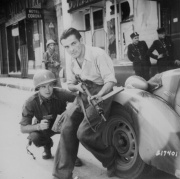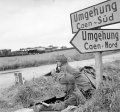Sten submachine gun
| |||||||||||||||||||||||||||||||||||||||||||||||||||||||||||
The Sten (or Sten gun) was a family of British 9 mm submachine guns used extensively by British and Commonwealth forces throughout World War II and the Korean War. They were notable for having a simple design and very low production cost.
STEN is an acronym, cited as derived from the names of the weapon's chief designers, Major Reginald Shepherd and Harold Turpin, and EN for Enfield.[1] Over 4 million Stens in various versions were made in the 1940s.
The official designation "Carbine, Machine, Sten" should not be confused with the common understanding of carbine; the Sten was a typical, almost stereotypical submachine gun while the term carbine is used to refer to short, light rifles. The "Carbine, Machine" element of the designation resulted from the British term for a submachine gun - "Machine Carbine" - in the early part of the Second World War.
Contents |
History
The Sten emerged while Britain was engaged in the Battle of Britain, facing invasion by Germany. The army was forced to replace weapons lost during the evacuation from Dunkirk while expanding at the same time. Prior to 1941 (and even later) the British were purchasing all the Thompson submachine guns they could from the United States, but this did not begin to meet demand. The American entry into the war at the end of 1941 placed an even bigger demand on the facilities making Thompsons. In order to rapidly equip a sufficient fighting force to counter the Axis threat, the Royal Small Arms Factory, Enfield, was commissioned to produce a significantly cheaper alternative.
The credited designers were Major R. V. Shepherd, OBE, Inspector of Armaments in the Ministry of Supply Design Department at The Royal Arsenal, Woolwich, (later Assistant Chief Superintendent at the Armaments Design Department) and Mr. Harold John Turpin, Senior Draughtsman of the Design Department of the Royal Small Arms Factory (RSAF) Enfield. Shepherd had been recalled to service after having retired and spending some time at BSA.
The Sten required a minimum amount of machining and manufacturing effort by using simple pressed metal components and minor welding. Much of the production could be performed by small workshops and the firearms assembled at the Enfield site. Over the period of manufacture the Sten design was further simplified: the most basic model, the Mark III, could be produced from five man-hours work. Some of the cheapest versions were made from only 47 different parts. It was distinctive for its bare appearance (just a pipe with a metal loop for a stock), and its horizontal magazine. The Mark I was a more finely finished weapon with a wooden foregrip and handle; later versions were more spartan.
The Sten was replaced by the Sterling submachine gun from 1953, being slowly withdrawn from British service in the 1960s. The other Commonwealth nations made or adopted their own replacements. The Sten was used extensively by Jewish partisans during the Israeli War of Independence.
Design
The Sten was a simple, open bolt, blowback operated, selective-fire firearm firing 9 mm pistol ammunition. Single shots and fully automatic fire were selected by a cross-bolt type push-button located in front and above the trigger. The tubular receiver and the barrel sleeve were made from rolled steel. The Sten was fed from a box magazine attached to the housing on the left side of the gun. Various stocks were used with different models, from all steel skeleton and tubular stocks to wooden stocks and pistol grips. The sights were fixed, consisting of a rear peep and front blade, zeroed to a nominal 100 yards.[2]
Stoppages could occur due to a variety of problems: some as a result of poor maintenance, while others were peculiar to the Sten. Carbon buildup on the face of the breech[3] or debris in the bolt raceway could cause a failure to fire, while a dirty chamber could cause a failure to feed.[4] Firing the Sten by grasping the magazine with the supporting hand tended to wear the magazine catch, altering the angle of feed and causing a failure to feed. Then there was the Sten's magazine, which was a direct copy of the one used in the German Erma MP38/MP40, originally in order to facilitate the use of German 9 mm magazines.[5] Unfortunately, this decision necessarily incorporated the Erma magazine's faults in the process. The magazine had two columns of 9 mm cartridges arranged side-by-side in an alternating arrangement, merging at the top to form a single column. While other staggered magazines, such as the Thompson, fed from both the left and right side alternately (double-column, double feed), the Sten magazine, like the MP38, required the cartridges to gradually merge at the top of the magazine to form a single column (double column, single feed). As a consequence, any dirt or foreign matter in this taper area could cause feed malfunctions. Additionally, the walls of the magazine lip had to endure the full stresses of the rounds being pushed in by the spring. This, along with rough handling could result in deformation of the magazine lips (which required a precise 8° feed angle to operate), resulting in misfeeding and a failure to fire. To facilitate easier loading when attempting to push the cartridges down to insert the next one, a magazine filler tool was developed and formed part of the weapon's kit. Modern 9 mm magazines, such as those used by the Sterling SMG, are curved and feed both sides to avoid this problem. If a Sten failed to feed due to jammed cartridges in the magazine, standard practice to clear it was as follows: remove magazine from Sten, tap the base of the magazine against the knee, re-insert magazine in Sten, then recocking the weapon and firing again as normal.[4]
The slot on the side of the body where the cocking knob ran was also a target of criticism, as the long opening could allow foreign objects to enter. On the other hand, a beneficial side-effect of the Sten's minimalist design was that it would fire without any lubrication.[4] This proved useful in desert environments such as the Western Desert Campaign, where oil attracted and retained dust and sand.
The Sten underwent various design improvements over the course of the war. For example, the Mark 4 cocking handle and corresponding hole drilled in the receiver were created in order to prevent an accidental discharge issue. However, most changes to the production process were more subtle, designed to give greater ease of manufacture and increased reliability. Sten guns of late 1942 and beyond were, in general, highly effective weapons, though complaints of accidental discharge continued through the end of the war. Such was the ease of manufacture that the Germans also produced a version of the Sten, the MP 3008, late in the war.
Variants
Sten guns were produced in several basic marks, (though the MKI saw limited service, and the MKIV was never issued) and nearly half of the total produced were of the Mark II. Approximately 4.5 million Stens were produced during the war.
Mark I
The first ever Mk I Sten gun (number 'T-40/1' indicating its originator Harold Turpin, the year 1940 and the serial number "1") was handmade by Turpin at the Philips Radio works at Perivale, Middlesex during December 1940/January 1941. This particular weapon is held by the historical weapons collection of the British Army's Infantry and Small Arms School Corps in Warminster, Wiltshire.[6]
The first model had a conical flash hider and fine finish. It had a wooden foregrip and forward handle (sometimes this was made of steel), as well for a section of the stock. The stock was a small tube outline, rather like the Mark II Canadian. One unique feature was that the front pistol grip could be rotated forward to make the firearm easier to stow. The barrel sleeve extended all the way to the end, where it had conical flash hider. Along the top of the tube surrounding the barrel was a line of small holes and its sights were configured somewhat differently. About 100,000 were made before production switched to the Mark II. Sten Mk I's in German possession were designated MP.748(e).
Mark I*
This was the first simplification of the Mk I. The foregrip, the wooden furniture and the flash hider were deleted for production expediency.[7]
Mark II
The Mark II was the most prolific, at two million units produced. It was a much rougher weapon than the Mk I. The flash eliminator and hand guard (grip) of the Mk I were eliminated. Other changes included a removable barrel which projects 3 inches beyond the barrel sleeve and the magazine housing rotates to form cover for ejection opening. The barrel sleeve was shorter and rather than have small holes on the top, it had three sets of three holes equally spaced on the shroud. Sten Mk II's in German possession were designated MP.749(e). Some MkIIs were fitted with a wooden stock.Regular Mark II:
- Overall Length: 762 mm (30 in)
- Barrel Length: 197 mm (7.8 in)
- Weight: 3.2 kg (7.1 lb)
Mark II (Canadian)
During World War II a version of the Sten gun was produced at the Long Branch Arsenal in Long Branch, Ontario now part of Toronto, Ontario. This was very similar to the regular Mark II, with a different stock slightly improved quality. It was first used in combat in the Dieppe Raid in 1942.
Mark II:
- Overall Length: 896 mm (35.3 in)
- Barrel Length: 198 mm (7.8 in)
- Weight: 3.8 kg (8.4 lb)
Mark III
This simple design was the next most commonly produced after the Mark II. It was a simplification of the Mk I made both in Canada and the UK. Lines Bros Ltd. was the largest manufacturer. The biggest difference from the Mark II was the unification of the receiver, ejection port, and barrel shroud that now extended farther up the barrel. The barrel was fixed and the body was welded shut along the centre of the top. Captured Sten Mk IIIs in German possession were designated MP.750(e).
Mark IV
The Mark IV was a smaller version which did not progress beyond the prototype stage. It was near pistol-sized and it had a different configuration with a conical flash hider, a rear pistol grip, a very light stock and a much shorter barrel.
Mark V
Changes included a wooden grip, a wooden fore grip, a wooden stock, and a bayonet mount. The Sten bandolier issued to paratroopers held 7 full magazines.
Mark VI
- Overall Length: 908 mm (35.7 in)
- Barrel Length: 198 mm (7.8 in)
- Weight: 4.5 kg (9.9 lb)
Suppressed models
Mark IIS and Mark VIS models (sometimes recorded as 6(s)) were produced which incorporated an integral supressor. This would heat up rapidly when fired and a canvas cover was laced around for some protection. The Mark 6 had a lower muzzle velocity than the others; 305 m/s (1,001 ft/s) and was also the heaviest regular version due to the added weight of the specially designed silencer, as well as using a wooden pistol grip and wooden stock. Sten Mk IIS's in German possession were designated MP.751(e).
The suppressed models were produced at the request of the Special Operations Executive (SOE) for use by their teams in occupied Europe. Starting with the Mk. IIS in 1943.
Foreign built copies and derivatives
Norwegian Sten
In German-occupied Norway the resistance, under leadership of Bror With, created a large number of Sten guns from scratch, mainly to arm members of the underground army Milorg.
Danish Sten
Several groups in the Danish resistance movement produced Sten guns for their own use. BOPA produced around 200 Sten guns in a bicycle repair shop on Gammel Køge landevej (Old Køge road) located south of Copenhagen. Holger Danske produced about 150 Sten guns in workshops in Copenhagen. Employees of the construction company Monberg og Thorsen produced approximately 200 - 300 Sten guns in what is now the municipality of Gladsaxe - a suburb of Copenhagen for use by Holger Danske and other groups. Resistance groups 'Frit Danmark' and 'Ringen' also built a significant number of Sten guns.
Polish Sten
- Main article: Błyskawica submachine gun
The Polish resistance was provided with numerous Stens of various models by the SOE and the Cichociemni (Polish for Silent dark ones). Between 1942 and 1944, approximately 11,000 Sten Mk IIs were delivered to the Armia Krajowa. Due to the simplicity of design, local production of Polish variants of Sten was started in at least 23 underground workshops in Poland. Some of them produced copies of Mark IIs, while others produced the so-called Polski Sten. The Polski Sten made in Warsaw under command of Ryszard Białostocki were built from a number of legal elements made in official factories or acquired through other means. The main body of the machine pistol was made from hydraulic cylinders produced for hospital equipment. All the pistols were marked in English to disguise their origin and the production facilities. A modernized version of the Sten was produced in Poland under the name Błyskawica.
Gerät Potsdam
In late 1944, the Mauser works in Germany started manufacturing a series of copies of British Mk II Sten for diversion and sabotage purposes. The series was nicknamed the Gerät Potsdam and approximately 28,000 weapons were made.
MP 3008
In early 1945, Germany was seeking a cheap machine pistol for the Volkssturm. For that purpose a modified Sten was designed by Mauser and named the MP 3008. The main difference was the magazine attached below the weapon. Altogether, roughly 10,000 pieces were produced before the end of World War II.
Neumünster Device
The Neumünster Device was manufactured prior to the MP3008 under great secrecy by Mauser Waffenfabrik. The Neumünster device was an almost perfect copy of the British Sten, even down to its British proof marks. The reason for manufacturing the Neumünster Device is unknown but they were manufactured at great expense. Each Neumünster Device cost eight times as much as a Mauser Model 98K rifle.
Austen MK I
The Mark I Austen (from "Australian Sten") was a 9 millimeter Australian submachine gun derived from the British Sten gun developed during the Second World War by the Lithgow Small Arms Factory. Approximately 45,000 Austens were produced from 1942 to 1944. They remained in service as a standard weapon of the Australian Army until 1966.
Sputter Gun
An American invention, the Sputter Gun was designed to circumvent the law that defined a machine gun as something that fired multiple rounds with one pull of the trigger. The Sputter Gun had no trigger, but fired continuously after loading and the pulling back of its bolt, firing until it ran out of ammunition. The gun was very short lived as the ATF quickly reclassified it.
Service
The Sten, especially the Mark II, tended to attract affection and loathing in equal measure. Its peculiar appearance when compared to other firearms of the era, combined with sometimes questionable reliability made it unpopular with some front-line troops.[8] It gained nicknames such as "Plumber's Nightmare", "Plumber's Abortion", or "Stench Gun". The Sten's advantage was its ease of mass-production manufacture in a time of shortage during a major conflict.
Made by a variety of manufacturers, often with subcontracted parts, some early Sten guns were made poorly and/or not made to specification, and could malfunction in operation, sometimes in combat.[9] The double-column, single-feed magazine copied from the German MP40 was never completely satisfactory, and hasty manufacturing processes often exacerbated misfeed problems inherent in the design. A common statement heard from British forces at the time was that the Sten was made 'by Marks and Spencer out of Woolworth.'[10]. British and Commonwealth forces in the early years of the war often extensively test-fired their weapons in training to weed out bad examples; a last-minute issue of newly-manufactured Stens prior to going into action was not always welcomed.
The MK II and MK III Stens were regarded by many soldiers as very temperamental, and could accidentally discharge if dropped or even laid on the ground whilst the gun was cocked.[10]. Others would fire full-automatic when placed on 'single', or fire single shots when placed on 'automatic'.[10] This was particularly true of early Stens using bronze bolts, where the sear projection underneath the bolt could wear down more easily than ones made of case-hardened steel.
Stens could jam at inopportune moments. One of the more notable was the assassination of Reinhard Heydrich on 27 May 1942, when Slovak soldier - Warrant Officer Jozef Gabčík fired his Sten point blank at Heydrich, which misfired. Another partisan hastily tossed a grenade, which mortally wounded Heydrich.[9] There are other accounts of the Sten's unreliability, some of them true, some exaggerated and some which are apocryphal. France[11] manufactured (well-made) Sten copies postwar into the early 1950s, evidently believing in the basic reliability and durability of the design.
A well-maintained Sten gun was a devastating close-range weapon for sections previously armed only with bolt-action rifles. In addition to regular British and Commonwealth military service, Stens were air-dropped in quantity to resistance fighters and partisans throughout occupied Europe. Due to their slim profile and ease of disassembly, they were good for concealment and guerrilla warfare. Guerrilla fighters in Europe became adept at repairing, modifying and eventually scratch-building clones of the Sten (over 2,000 Stens and about 500 of similar Błyskawica SMGs were manufactured in occupied Poland).
Canadian infantry battalions in North-West Europe held spare Sten guns for special missions and the Canadian Army reported a surplus of the weapons in 1944. The Sten was not used in Italy due to constraints on the shipping of ammunition; .45 ACP was already being used in theatre by the US Army and a requirement for 9 mm would have been in competition with limited shipping space.
The Sten saw use even after the economic crunch of World War II, replacing the Royal Navy's Lanchester submachine guns into the 1960s and was used in the Korean War including specialist versions for British commandos. It was slowly withdrawn in the 1960s and replaced by the Sterling SMG in British Army service, while Canada adopted a similar weapon, the C1 SMG to replace the Sten.
The Sten was one of the few weapons that the State of Israel could produce domestically during the 1948 Arab-Israeli War. Even before the declaration of the State of Israel, the Yishuv had been producing Stens for the Haganah; after the declaration, Israel continued making Stens for IDF use. The opposing side also used (mostly British-made) Stens, particularly the irregular and semi-regular Arab Liberation Army. [12]
In the 1950s "L numbering" came into use in the British Army for weapons - Stens were then known as L50 (Mk II), L51 (Mk III) and L52 (Mk V).
One of the last times the Sten was used in combat during British service was with the Royal Ulster Constabulary during the IRA border campaign of 1956 - 1962. In foreign service, the Sten was used in combat at least as recently as the Indo-Pakistani War of 1971.
In 1971 various marks of Stens were used by guerilla fighters during the Bangladesh Liberation War.
A number of suppressed Stens were in limited use by the US Special Forces during the Vietnam war, including circa 1971, by the United States Army Rangers.[13][14][15]
In 1984, Indira Gandhi was assassinated by two of her Sikh bodyguards, one of whom emptied the entire magazine of his Sten into the Prime Minister at point-blank range.
In the Chinese Civil War, both sides used the Sten.
The Finnish Army acquired moderate amounts of Stens in the late 1950s, mainly Mk. III versions. Refurbishment at at the Kuopio Arsenal included bluing of the arms. Stens in Finnish service saw limited usage by conscripts (notably combat swimmers) and were mostly stockpiled for use in a future mobilization.
Users
- Commonwealth of Nations
- Finland
- France
- Norway
- Poland
- United Kingdom
- United States
- Canada
- China
See also
Gallery
Sten Mk IIS (suppressed)
Sten Mk VIS (suppressed)
British Paratroops with Sten Mk Vs on D-Day +1
Canadian soldier holding Sten Mk II guards German prisoners captured at Juno Beach on D-Day - 6 June 1944
Resources
| Gun Owners' Resource has the following relevant documents available for free download for the Sten submachine gun and/or its variants: |
- Carbines, Machine, Sten, 9mm. Mks. I, II & III Illustrated Identification List C.O.D. (Technical Branch), Weedon, August 1942 (23-page, 780KB .pdf file)
- Carbine, Machine, Sten 9mm. Mk. II General Instructions Feb, 1942 (9-page, 710KB .pdf file)

This article is either missing some diagrams which would help to illustrate a proper breakdown of the firearm in question or the diagrams which are here are inadequate. This article could use more input to fill in the missing bits. You (yes, you!) can help Gunsopedia provide more comprehensive information to our users by using your own knowledge to add to it.
Notes and References
- ↑ Not all sources agree. Colonel Shepherd discussing how it was named when he received an Award from the Board of the Royal Commission Awards to Inventors. Lord Cohen: "Why was it called the Sten?" Colonel Shepard: "It was called the Sten by the then Director General of Artillery. The S' was from my name, the T from Mr. Turpin who was my draughtsman and who did a very large amount of the design and the EN was for England. That is the origin of the name, for which I accept no responsibility." In:Laidler, Peter (2000). The Sten Machine Gun. Ontario: Collector Grade Publications. pp. 363–364. ISBN 0889352593. In the official history of the Royal Ordnance Factories, ST is for Shepard and Turpin and EN is for Enfield. In: Ian Hay (Maj.-Gen. John Hay Beith, CBE, MC) (1949). R.O.F. The Story of the Royal Ordnance Factories, 1939-1948. London: His Majesty's Stationery Office.
- ↑ Popenker, Max. Modern Firearms - STEN submachine guns
- ↑ Carbine, Machine, STEN 9mm Mk II, General Instructions, (February 1942) Manual: Heavy carbon buildup could prevent the firing pin from detonating the primer.
- ↑ 4.0 4.1 4.2 Carbine, Machine, STEN 9mm Mk II, General Instructions, (February 1942)
- ↑ Dunlap, Roy F., Ordnance Went Up Front, Samworth Press (1948), p. 80
- ↑ [1]
- ↑ Skennerton, Ian (September 1988). British Small Arms of World War 2: The Complete Reference Guide to Weapons, Codes and Contracts, 1936-1946.. Greenhill Books. pp. 32. ISBN 0-949749-09-5.
- ↑ Weeks,John, World War II Small Arms, Galahad Books (1979), ISBN 0883654032, p. 84
- ↑ 9.0 9.1 Willbanks, James H., Machine Guns: An Illustrated History of Their Impact, ABC-CLIO Press (2004), ISBN 1851094806, 9781851094806, p. 91
- ↑ 10.0 10.1 10.2 Shore, C. (Capt), With British Snipers to the Reich, Paladin Press (1988), p. 208-209
- ↑ http://stenguns.tripod.com/id12.html
- ↑ Morris, Benny (2008). 1948: A History of the First Arab-Israeli War. Yale University Press. ISBN 9780300126969.
- ↑ http://25thaviation.org/history/id908.htm
- ↑ http://oftheirownaccord.com/pics/Britishsten.jpg
- ↑ http://www.militaryphotos.net/forums/attachment.php?attachmentid=41525&d=1201022200
External links
- Various high-resolution photos of the Sten Mk II, III and V
- How to field-strip a Sten
- Complete machinist's plans to manufacture a Sten Mk II
- Sten at Modern Firearms
- REME Museum
- Ode to a Sten gun (audio recording)
- Videoes of Sten in use
- Sten Mk II being fired
- Another Sten Mk II being fired
- Sten Mk V showing comparative tests with the German MP40
- Sten Mk II - 2 round bursts
- Sten Mk II - 3 round bursts
- Sten Mk II - 2, 3 and 5 round bursts
- Sten Mk II - 5 round bursts
- Sten Mk II - one long burst that empties the magazine
- Sten Mk III - comparison with 2 other SMGs
- Sten Mk II Suppressed]
| Side Arms | Webley Mk IV & Mk VI Revolvers· Enfield No. 2 Mk I Revolver· Browning GP-35 "High Power" Pistol· Smith & Wesson "Victory" Revolver· Welrod | |
|---|---|---|
| Rifles & submachine guns | SMLE No.1 Mk III* & Lee-Enfield No.4 Mk.I· Lee-Enfield No.5 Mk.I "Jungle Carbine"· De Lisle Commando Carbine· Sten SMG· Lanchester SMG· Austen SMG· Owen Gun· Welgun | |
| Machine-guns & big stuff | Bren gun· Charlton Automatic Rifle· Lewis Gun· Vickers MG· PIAT· Rifle, Anti-Tank, .55 in, Boys· SBML 2inch Mortar· ML 3-inch Mortar· No.2 "Lifebuoy" Flamethrower | |
| Grenades | British grenades of WWI and WW2 · Mills Bomb | |
| Small arms cartridges | .303 British· 9mm Parabellum· .45 ACP· .455 Webley· .38/200· .38 Special· .50 BMG | |
